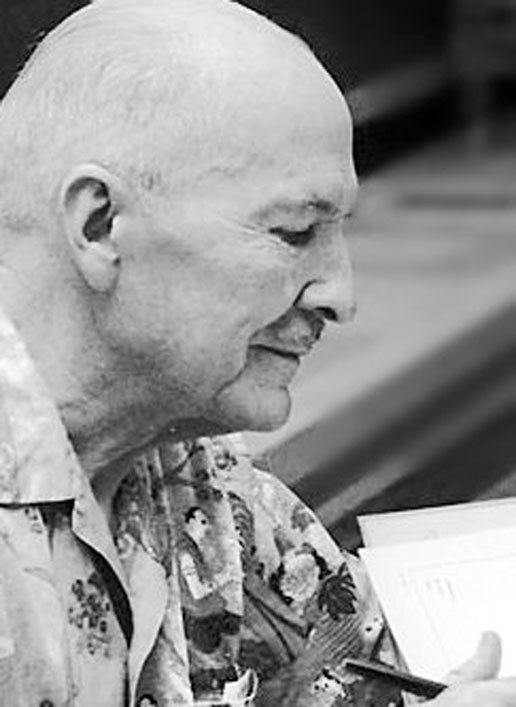My science-fiction book club had two reasons for choosing Robert
Heinlein’s novel
”
Starship Troopers
”
to chat about this month. One was that Heinlein would have been
100 years old Saturday. The other is that he once lived in our
coastal California region.
My science-fiction book club had two reasons for choosing Robert Heinlein’s novel “Starship Troopers” to chat about this month. One was that Heinlein would have been 100 years old Saturday. The other is that he once lived in our coastal California region.
One of the America’s most influential – and controversial – writers, Heinlein lived a few miles west of the South Valley region in a futuristic house set in the Santa Cruz Mountains. During his life, his writing won many awards. Enthusiasts consider him one of the three “grandmasters” of modern science fiction, along with Isaac Asimov and Arthur C. Clarke.
Born on July 7, 1907, Heinlein grew up in Kansas City, Mo. In 1929, he graduated from the U.S. Naval Academy and served as an officer, eventually reaching the rank of lieutenant. His Navy experience would greatly influence his novels, especially the highly militaristic “Starship Troopers.”
The Navy discharged Heinlein in 1934 due to his severe case of pulmonary tuberculosis. He spent months under hospitalized bed rest, and during this period his mind came up with an idea for a liquid-filled mattress. In his books, he later described this unusual invention and inspired other people to create “water beds.”
Heinlein’s passion for improving society propelled him in 1934 to campaign for socialist author Upton Sinclair, then running as the Democratic nominee for governor of California. Sinclair lost the election, but Heinlein’s evolving political zeal pushed him to run for the California State Assembly in 1938. When he lost, his life took another turn. He found himself writing science-fiction action tales for pulp magazines.
Struggling to pay his mortgage, Heinlein started writing fiction to earn extra money. His first story, titled “Life-Line,” was published in Astounding Science-Fiction magazine in 1939. Over time, he gained a widening reputation as an important writer in the new genre of socially-focused science fiction. His impressive quality of writing even got his stories published in the Saturday Evening Post.
Despite Heinlein’s reputation, one publisher in 1946 rejected the author’s first novel, “Rocket Ship Galileo.” It described the adventure of three boys voyaging to the Moon in an atomic-powered spacecraft they’d built. The publisher’s editors informed Heinlein that “real scientists” knew voyages into outer space were utterly impossible.
Heinlein inspired a whole generation of engineers and physicists with his realistic approach to telling science-based stories that were socially relevant. His tales even helped inspire television’s Gene Roddenberry to produce “Star Trek,” a show that used science fiction to grapple with the social issues.
In the 1960s, Heinlein gained mass-market fame with best-selling novels such as his ground-breaking “Stranger in a Strange Land,” published in 1961, and “The Moon is a Harsh Mistress,” published in 1966. The fortune he earned from these and other works enabled him and his wife Virginia to purchase several acres in the Santa Cruz Mountains not far from Henry Cowell Redwoods State Park. In 1967, they moved into their custom-built home on the property. Designed in a flowing curve, it looked like one of Heinlein’s spaceships might have landed among the redwood trees. Heinlein built a high fence around the house to keep out the literary loonies who believed he was a philosophical “guru.” The Heinleins lived in their Santa Cruz Mountain home until 1987 when, due to declining health, the author moved to Carmel. He died there in his sleep on May 8, 1988.
Reading his “Starship Troopers” recently for discussion, I noted how Heinlein’s controversial best-seller stirs up questions relating to how America might be now evolving as the world’s military colossus. A recent New York Times Book Review article called the novel “an endorsement of fascism,” but I see it more as a warning of how citizens can quickly lose their freedoms and privileges when they become complacent to political involvement. The book portrays a futuristic society in which only military veterans have the right to vote or hold public office, and its central theme looks at how an ongoing fear of enemy attack can caustically shape the character of a nation. That’s an issue the United States must face today with its own social transformation from ongoing and politically-manipulated terror threats.
On the 100th anniversary of his birth, legions of Heinlein fans will no doubt discuss his relevance to today’s literature and culture. The writer, who for 20 years lived not far from the South Valley, can offer us wise words of caution about what political dangers might lie hiding ahead.












